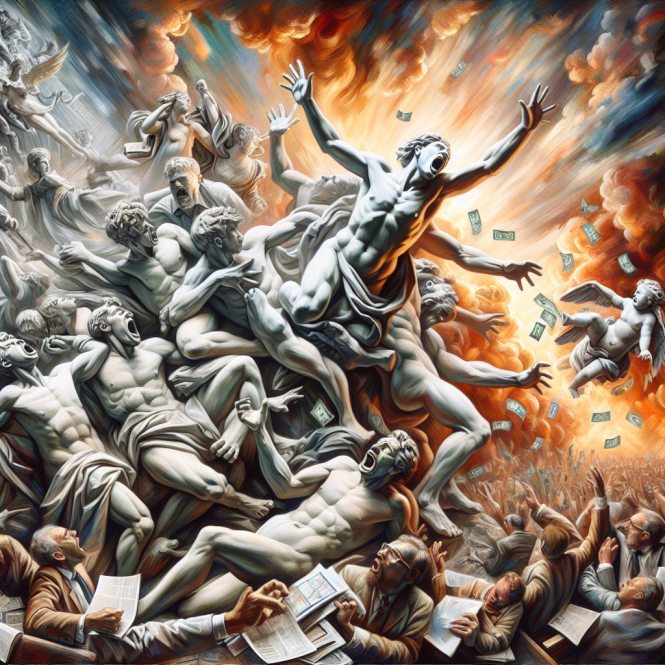How Did Panic Selling Affect the Stock Market? A Tale of Financial Ruin for the Masses
Introduction: How Did Panic Selling Affect the Stock Market During Covid Crises?
May 28, 2024
The global Covid-19 pandemic has profoundly impacted the world in many ways. One of its most significant effects has been on the stock market, where panic selling has been widespread as investors reacted to the economic uncertainty and fear generated by the pandemic. This essay will explore how panic selling affected the stock market during Covid, drawing comparisons to earlier market crashes in 1929 and 1987. It will argue that the same stupidity and fear that drove those crashes continue to reign supreme today, with investors still failing to learn from past mistakes. However, it will also show how panic selling can be a golden long-term opportunity for those who apply the principles of mass psychology and technical analysis.
The 1929 and 1987 Stock Market Crashes: A Cautionary Tale
The stock market crash of 1929 and the Black Monday crash of 1987 are two of history’s most famous examples of panic selling. Both events were characterized by widespread fear and uncertainty, with investors rushing to sell their stocks in a futile attempt to minimize their losses. In both cases, this panic selling led to a sharp decline in the stock market, with devastating consequences for many investors.
However, the most striking similarity between these two crashes is the role that stupidity and fear played in driving them. In both cases, investors were driven by irrational fear and a lack of understanding of the underlying economic fundamentals. This led to a self-fulfilling prophecy, as investors’ panic selling only exacerbated the market’s decline.
As the famous saying goes, “History doesn’t repeat itself, but it often rhymes.” Unfortunately, this seems to be the case regarding panic selling in the stock market. Despite the lessons of history, investors continue to be guided by fear and irrationality during market downturns, with little regard for the long-term consequences of their actions.
The Role of Mass Psychology in Panic Selling
One key factor driving panic selling in the stock market is mass psychology. This refers to the collective behaviour and emotions of a large group of people, which can significantly impact market prices. In times of crisis or uncertainty, investors often react in a herd-like manner, with many following the lead of others without considering the underlying fundamentals.
This phenomenon was famously described by the philosopher Plato, who compared the masses to a ship’s crew, with each member blindly following the captain without understanding the proper direction of the boat. This concept was also echoed by the Renaissance humanist Erasmus, who wrote that “stupidity is the greatest force in the universe,” and by the French essayist Montaigne, who observed that “people are stupid.”
Technical Analysis as a Way to Identify Panic Selling Opportunities
Despite the challenges posed by mass psychology and panic selling, there are ways for investors to identify long-term opportunities in the stock market. One such approach is technical analysis, which involves analyzing price charts and other market data to identify trends and patterns in the market.
By applying the principles of technical analysis, investors can identify when panic selling is likely to occur and use this information to buy stocks at discounted prices. This can be a highly effective strategy for those willing to take a long-term view of the market and are not swayed by short-term fluctuations.
The Importance of Learning from Past Trends and Mistakes
As the famous investor Warren Buffett once said, “In the business world, the rearview mirror is always clearer than the windshield.” This is a powerful reminder of the importance of learning from past trends and mistakes to make informed decisions in the future.
In the context of panic selling during the Covid-19 pandemic, it is clear that investors have much to learn from the past. By studying the patterns and behaviours that have driven previous market crashes, investors can better understand the underlying forces that shape the market and use this knowledge to make more informed decisions in the future.
To achieve this, investors must be willing to challenge their own assumptions and question the prevailing narratives that dominate the market. This requires a willingness to think independently and to go against the herd mentality that often drives panic selling.
The Importance of Emotional Intelligence in Investing
Finally, investors must recognize the critical role that emotional intelligence can play in achieving long-term success in the stock market. By cultivating self-awareness and self-regulation, investors can better manage their emotions and avoid making impulsive decisions based on fear or greed.
This requires a commitment to ongoing personal development and self-reflection as well as a willingness to seek feedback and advice from others. By doing so, investors can develop the emotional resilience and maturity necessary to navigate the challenges and opportunities that lie ahead.
The Role of Discipline and Patience in Long-Term Investing
Finally, investors must recognize the critical role that discipline and patience can play in achieving long-term success in the stock market. By staying true to their investment strategy and avoiding the temptation to make impulsive decisions based on short-term market fluctuations, investors can position themselves for success over the long run.
This requires a commitment to staying focused on one’s long-term financial goals and a willingness to endure periods of volatility and uncertainty in pursuing those goals. By doing so, investors can cultivate the emotional resilience and mental toughness necessary to navigate the challenges and opportunities that lie ahead.
Conclusion: How Did Panic Selling Affect the Stock Market?
Panic selling during market crises is a recurring theme in stock market history, as investors are often guided by fear and irrationality rather than long-term thinking. Examples include the 1929 crash, the 1987 Black Monday, the 2000 dot-com bubble burst, and the 2008 financial crisis.
However, savvy investors who apply mass psychology and technical analysis principles can identify opportunities amidst the panic. Strategies like looking for highly oversold conditions, high volume capitulation selling, and stocks that have held up well during the decline can highlight potential long-term buying opportunities.
Famous investors like Warren Buffett and John Templeton have used market panics to acquire stocks at bargain valuations. As Buffett has said, “Be fearful when others are greedy, and greedy when others are fearful.”
From now on, investors must learn from history to avoid repeating costly mistakes. Investors can navigate market turbulence by staying rational, unemotional, and focused on underlying business fundamentals and long-term prospects and positioning themselves for future success. Applying the hard-won lessons of past generations is essential for the next generation of investors.
Other articles of interest

How would a successful investor define emotional discipline?

Skip Human Psychology Books: Learn Everything from the Market

Why should I invest in stocks?

What is efficient market hypothesis?

Who Actually Trades Market Retracements?

Ayer Logical Positivism: The Art of Rational Discourse in Philosophy

Unveiling Social Manipulation: The Media’s Covert Agenda

Vienna Circle Logical Positivism: Bridging Science and Philosophy

Bearish Sentiment Index: The Impact of Mass Psychology

Contrarian Investing Success: Dividend Harvesting Seeking Alpha

Bear Market Behaviour: Mastering the Art of Resilience

Navigating Cognitive Bias through Logical Positivism Philosophy

Navigating the Dunning-Kruger Effect Valley of Despair

Cognitive Bias and Its Impact on Logical Positivism Meaning




